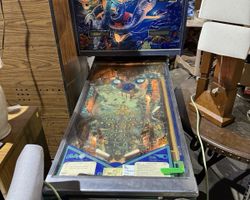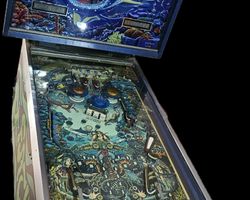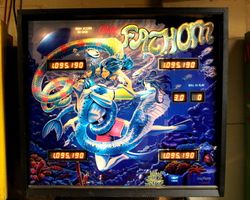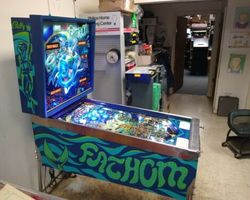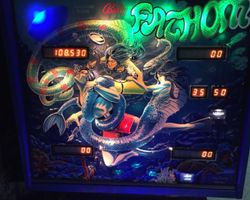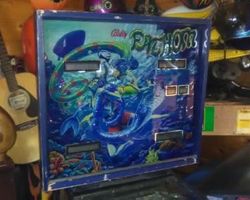Fathom
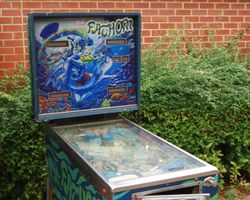
Average Prices: USD $900 to $5,100
Produced: August, 1981
Production Run: 3,500 units
Machine Type: Solid State Electronic
MPU: Bally MPU AS-2518-35
Players: 4
Design by: Ward Pemberton
Art by: Greg Freres
Dots/Animation by: Kevin OConnor
Bally Manufacturing Corporation unveiled Fathom in August 1981, a solid-state pinball machine that quickly established itself within the competitive landscape of the early 1980s. Designed by Ward Pemberton, with the distinctive artistic vision of Greg Freres leading the graphical effort and Rehman Merchant crafting the software, Fathom represents a distinct period in pinball evolution. The machine’s aquatic theme, centered around mermaids, ocean depths, and an aura of fantasy, was a departure from typical themes of the era and instantly captivating.
The conceptualization of Fathom involved a collaborative process, as is common in pinball design. Ward Pemberton initially conceived the game under the working title "Barracuda," reflecting its potential for fast, aggressive gameplay. Simultaneously, Greg Freres, the lead artist, envisioned his own title, "Deep Threat," complete with preliminary artwork that showcased his artistic direction. Neither name ultimately made it to production, with Bally management settling on "Fathom." This decision, however, did not detract from the strength of Freres's artistic contribution. His work on the backglass, playfield, and cabinet established a cohesive and immersive visual narrative. Kevin O'Connor also contributed, specifically to the machine's promotional brochure, creating a comic book-like aesthetic that echoed the game’s adventurous spirit. With a production run of 3,500 units, Fathom carved out its niche, becoming a recognizable and sought-after title from Bally's output during this period, notable for its unique Model Number 1233 designation in Bally's documentation.
Signature Features and Design
Fathom’s appeal stems significantly from its cohesive design and distinct features. The visual presentation stands out, largely due to Greg Freres's masterful artwork. The backglass, a tableau of enigmatic mermaids amidst an underwater realm, draws players into the theme before a single ball is launched. This ethereal quality extends to the playfield, where blues, greens, and purples dominate, depicting submerged ruins and coral formations. The integration of color and thematic elements across the playfield and cabinet is seamless, establishing an immersive, almost mystical, underwater environment.
Beyond the visuals, Fathom incorporates several mechanical and auditory elements that define its gameplay. Three flippers provide varied shot opportunities, with two at the bottom and a strategically placed third flipper higher on the playfield. The machine features custom speech, a technological advancement for its time, which adds an auditory layer to the thematic depth. Pop bumpers and slingshots animate the upper playfield, creating frenetic action. A key feature is the multi-ball capability, allowing for three balls in play simultaneously, a dynamic element that elevates the scoring potential and intensity. The generous deployment of drop targets, including a 6-bank, a 3-bank, and two sets of 3-in-line targets, provides clear objectives and rewarding feedback upon completion. These elements collectively enhance the player experience, blending visual allure with engaging mechanical interactions.
Playfield and Mechanics
The playfield layout of Fathom is a testament to classic pinball design, prioritizing shot variety and flow. Starting from the lower playfield, players are greeted by the two standard flippers, offering the primary means of controlling the ball. Above them, a central 6-bank of drop targets acts as a prominent objective, requiring precision to clear. To the left and right, slingshots propel the ball back into action, feeding the three pop bumpers located in the upper-left quadrant. This area also houses a spinning target, which rewards continuous hits with escalating points.
Moving up the playfield, two kick-out holes provide specific targets, often associated with ball locks for multi-ball initiation or bonus accumulation. One of the machine's signature features involves the distinct in-lane and out-lane arrangement: rather than traditional paths, Fathom incorporates left and right crossover return lanes that divert the ball across the playfield. This subtle but effective design choice keeps players on their toes, altering the expected flow and demanding adaptive flipper work.
The playfield's visual narrative is reinforced by the strategic placement of objects. The two sets of 3-in-line drop targets are particularly integral, as clearing them is crucial for bonus progression. A single standup target and a pair of captive balls offer additional scoring opportunities and challenges. The lighting, while typical of the era's technology, effectively highlights key targets and pathways, guiding the player through the sub-aquatic landscape. The overall design philosophy emphasizes a challenging yet rewarding experience, where clearing targets and achieving multi-ball requires skill and thoughtful shot selection.
Gameplay Dynamics
Fathom’s gameplay mechanics revolve around a clear progression system, culminating in its high-scoring opportunities. The core objective often centers on systematically clearing the numerous drop targets. The 6-bank, 3-bank, and the two sets of 3-in-line targets each contribute to scoring and can activate various game states. Clearing the in-line drop targets, for instance, is directly linked to the bonus multiplier system, rewarding players for consistent accuracy. The maximum displayed score of 9,999,990 points per player encourages strategic play for high scores.
The pivotal gameplay mechanic is the 3-ball multi-ball. Achieving multi-ball often involves locking balls in the kick-out holes after hitting specific targets. Once initiated, multi-ball transforms the game into a fast-paced, high-risk, high-reward endeavor. Players must manage multiple balls simultaneously, aiming for high-value targets while trying to keep all balls in play. The spinner, located in the upper playfield, is another key scoring element, rapidly increasing in value with repeated hits, especially during multi-ball.
A unique challenge in Fathom is its in-lane/out-lane reversal mechanic. Balls that typically drain down the out-lanes can sometimes be diverted back into play via the crossover return lanes, offering a moment of reprieve or a strategic chance to reset. Conversely, what might appear to be a safe in-lane shot can sometimes lead to an unexpected drain. This unpredictable element adds a layer of depth and excitement, preventing gameplay from becoming overly predictable. Strategies often involve focusing on clearing drop targets to advance the bonus, then locking balls for multi-ball to maximize points. Mastering the flow of the crossover lanes and skillfully managing three balls in play are essential for achieving high scores and a memorable game.
Reception and Legacy
Fathom continues to be regarded as a significant achievement from Bally’s early solid-state era. The machine's overall reception has been overwhelmingly positive since its release. Enthusiasts and collectors frequently describe it as a classic, praising its balance of challenging gameplay and engaging features. The aesthetic appeal is a consistently highlighted strength, with the artwork being described as stunning and beautiful, effectively immersing players in its aquatic theme. The integration of color and visual storytelling across the backglass, playfield, and cabinet is frequently cited as a benchmark for thematic cohesion.
The gameplay itself is often commended for its challenging yet rewarding nature. The numerous drop targets, particularly the strategic placement of the in-line targets, provide satisfying objectives. The multi-ball feature is a cornerstone of its appeal, offering a thrilling, high-scoring experience. While some players, particularly those accustomed to later, more complex machines, occasionally perceive the gameplay as slower or less varied, the consensus leans heavily towards its compelling, addictive quality. The sound and custom speech, while limited by the technology of 1981, are generally appreciated for adding atmosphere and contributing to the thematic depth.
Fathom's legacy is firmly established within the pinball community. It is considered one of the stronger early solid-state machines from Bally, often featuring on collectors' lists as a highly desirable acquisition from that period. Its unique artistic direction, combined with its engaging mechanical features, set it apart. The machine’s enduring popularity has contributed to its value in the collector's market. Fathom's design ethos, emphasizing clear targets, a rewarding multi-ball, and a distinct aesthetic, showcased Bally’s capacity for creating captivating and well-balanced games, influencing subsequent designs within their portfolio and solidifying its place in pinball history.
Sponsored Links
 Ebay Listings
Ebay Listings
 Auction Results
Auction Results
| Cost | Location | Date |
|---|---|---|
| USD $3,150 |  Illinois, United States Illinois, United States |
12 September, 2025 |
| EUR €2,500 |  Nordrhein-Westfalen, Germany Nordrhein-Westfalen, Germany |
03 August, 2025 |
| USD $7,999 |  Florida, United States Florida, United States |
05 February, 2025 |
| USD $4,100 |  Ohio, United States Ohio, United States |
12 September, 2024 |
| USD $4,000 |  Michigan, United States Michigan, United States |
04 September, 2024 |
| USD $5,250 |  Colorado, United States Colorado, United States |
27 March, 2024 |
| USD $6,500 |  New York, United States New York, United States |
09 March, 2024 |
| USD $7,800 |  New York, United States New York, United States |
13 August, 2023 |
| USD $6,800 |  Illinois, United States Illinois, United States |
09 August, 2022 |
| USD $3,700 |  Nebraska, United States Nebraska, United States |
22 June, 2022 |


Private Policy · Search Website · Contact Us
As an eBay Partner, we may earn a commission from qualifying purchases made through links on this site, at no additional cost to you.
All trademarks and copyrighted materials remain property of their respective owners. All other content copyright 2007 - 2025 Pinpedia.

